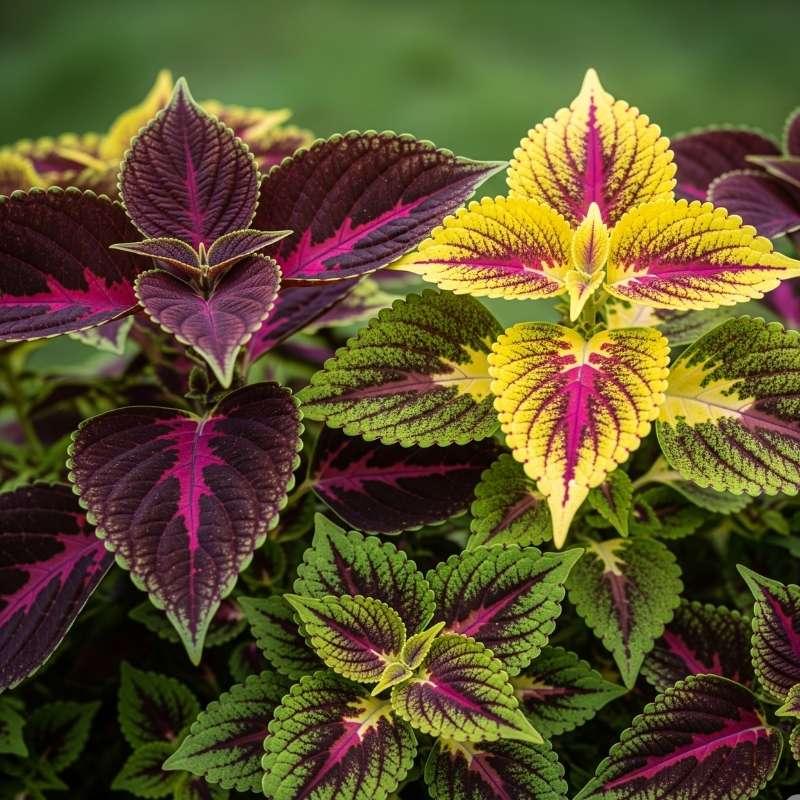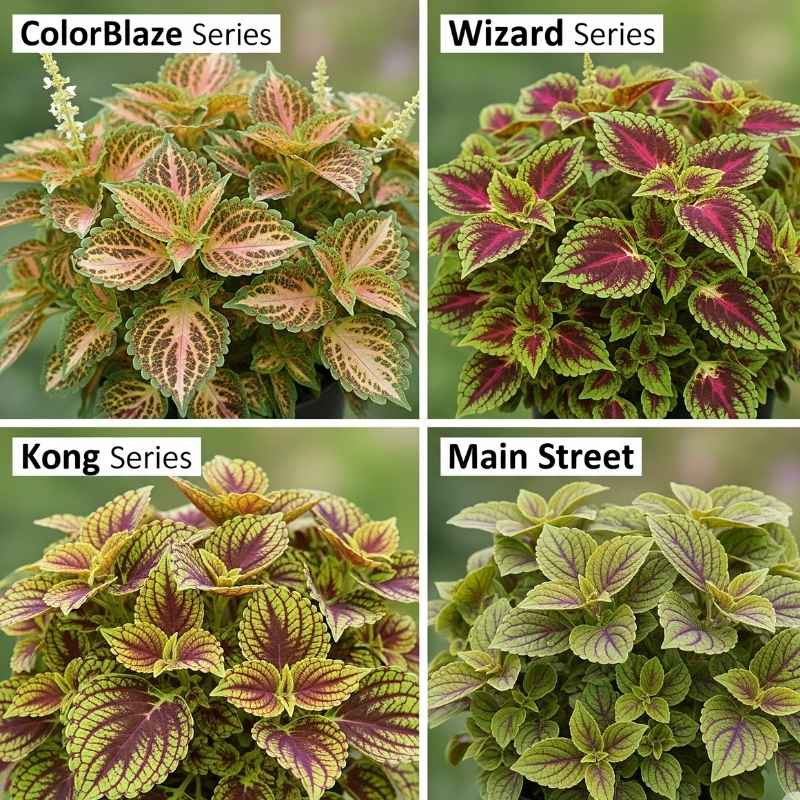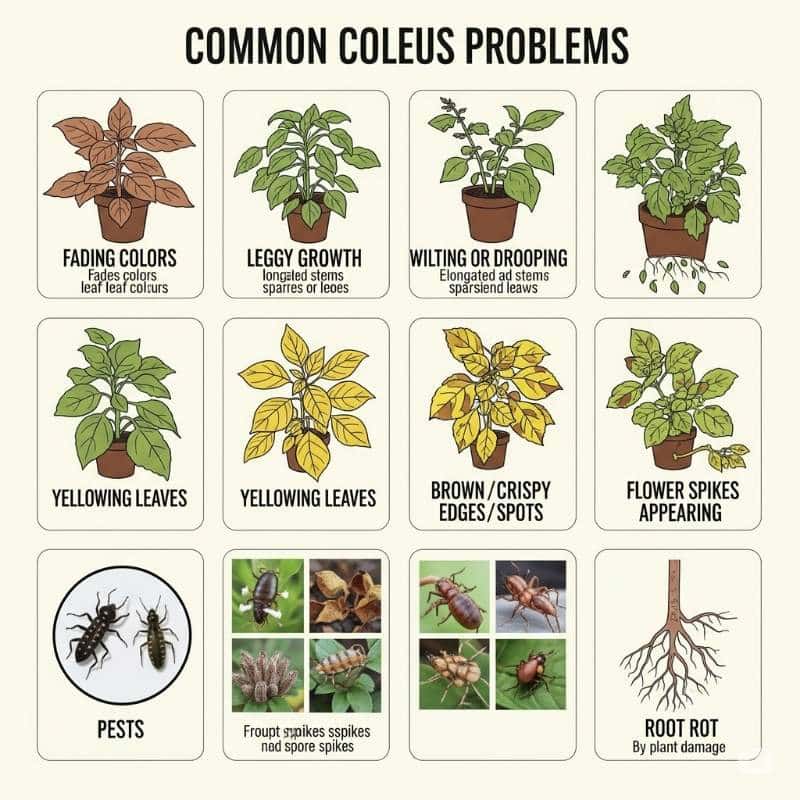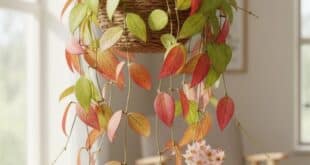Meet The Coleus Plant
Imagine a plant with leaves so incredibly vibrant and uniquely patterned, they look like they’ve been painted by a magical artist! That’s the dazzling Coleus plant (Plectranthus scutellarioides, though you might still hear its older names like Coleus blumei). This absolute showstopper is a true star in any garden or home, loved for its breathtaking foliage that comes in every color imaginable!

Hailing from the warm, shady forests of Southeast Asia, Coleus brings an unparalleled burst of living color and artistic flair wherever it grows. The Chinese Money Plant is wonderfully easy to grow, incredibly versatile (thriving indoors or outdoors!), and even easier to propagate. Ready to add this living work of art to your collection? Let’s uncover all the secrets to making your Coleus truly glow!
What Makes a Coleus Plant So Unique? Its Unbelievable Leaf Colors and Patterns!
When you look at a Coleus, you’ll be instantly mesmerized by its leaves. They’re typically soft and velvety to the touch, but it’s their explosive color that really captivates! Beyond just green, you’ll find them in fiery reds, sunny yellows, electric greens, deep purples, rosy pinks, earthy bronzes, and even nearly black.

What truly sets Coleus apart is not just the colors, but the endless patterns they create: bold veins that contrast sharply, splashes of different hues, intricate margins, or leaves divided into distinct color zones. It’s like each leaf is its own little painting! Unlike many plants grown for their flowers, with Coleus, the leaves are the main event – their tiny flower spikes are usually quite insignificant.
Where Do Coleus Plants Come From? Southeast Asia’s Shady Forests
Your Coleus plant’s ancestors come from the warm, shady, and moist forest floors of Southeast Asia (places like Indonesia and Malaysia) and even parts of Australia. Imagine thriving under the dappled sunlight of a dense tree canopy, surrounded by rich, damp soil! This background helps us understand why they appreciate good moisture, warmth, and that perfect balance of brightness without harsh direct sun in our homes and gardens.
What Are Its Other Names? “Painted Nettle” and Its Colorful Appeal
The most common nickname for Coleus is “Painted Nettle.” This name comes from how its leaves look a bit like nettle leaves, but don’t worry – they won’t sting you! The name perfectly captures its vibrant, artistic appeal and its lush, leafy presence. Its popularity has spanned generations because it’s such an easy and rewarding way to add instant, dramatic color.
What Kinds of Coleus Plants Are There?
The world of Coleus is truly a vast art exhibition, with breeders constantly creating new and even more astonishing varieties!

Popular Coleus Plant Types: A Kaleidoscope of Foliage Art
Coleus plants are often grouped by whether they prefer sun or shade, and by their incredible leaf patterns. Here are some favorites:
| Type of Coleus | Key Features & Colors | Light Hint | Looks Like… |
| ‘ColorBlaze’ Series | Bred for full sun tolerance! Comes in strong, vibrant mixes of red, green, bronze, yellow, and black. Often vigorous growers. | Sun | Bold, sturdy, sun-loving plants with amazing color. |
| ‘Wizard’ Series | Classic, shade-loving varieties. Heart-shaped leaves with unique patterns of pink, red, green, cream. | Shade | A beautiful, intricate tapestry of traditional Coleus colors. |
| ‘Kong’ Series | Features extra-large leaves in striking color combinations. Shade-loving, very dramatic. | Shade | Giant, dinner-plate-sized leaves in vibrant patterns. |
| ‘Main Street’ Series | Known for unique leaf shapes (like ruffled or deeply cut) and beautiful, vibrant color combos. | Sun or Shade | More unusual leaf textures with stunning colors. |
Leaf Looks: Colors, Patterns, and Shapes
The leaves are where Coleus truly dazzles! You’ll find an endless array of color combinations, with bright contrasting veins, bold splashes, intricate blotches, and distinct margins. Beyond color, the leaf shapes themselves vary widely: from classic heart-shaped to deeply cut, fringed, narrow, broad, or even wonderfully ruffled. It’s a plant that never gets boring!
Growth Habit: Bushy and Branching
Coleus plants naturally grow as bushy, upright plants. They love to branch out, creating a dense mound of vibrant foliage. However, they can get a bit “leggy” (stretched out) if they don’t get enough light or aren’t pinched regularly. Luckily, pinching helps keep them compact and encourages even more colorful growth!
How Do You Take Care of Your Coleus Plant?
Caring for a Coleus is delightfully simple, and the vibrant, eye-catching colors make it all the more rewarding! The biggest secret is giving them the right amount of light.

Coleus Care Summary
Here’s a quick overview of what your Coleus loves:
| Care Category | What Your Coleus Needs |
| Light | Bright, indirect light (most types). Sun varieties need 4-6 hours direct sun. |
| Watering | Consistently moist soil (top inch dry); don’t let it wilt. Reduce in winter. |
| Temperature | Warm, 60-85°F (15-29°C); avoid cold drafts. |
| Humidity | Moderate to high; appreciates occasional misting or grouping. |
| Soil | Well-draining, rich potting mix with drainage holes. |
| Potting | Repot when root-bound, or annually if growing as perennial. |
| Feeding | Feed your Coleus every 2–4 weeks during spring and summer using a diluted, balanced liquid fertilizer to support its vibrant growth and striking foliage. |
| Pruning | Regular pinching for bushiness; remove flower spikes. |
The Right Light: Bright, Indirect Light for Best Color!
This is the most crucial tip for keeping your Coleus looking its absolute best: light directly affects its leaf colors!
- Most classic Coleus types prefer bright, indirect light. Think of a spot near a window that gets lots of brightness but no harsh direct sun beating down all day – that can scorch their delicate leaves.
- However, many newer varieties (often labeled “Sun Coleus” or part of series like ‘ColorBlaze’) are bred to tolerate 4-6 hours of direct sun, which actually intensifies their colors!
- If your Coleus isn’t getting enough light, its vibrant patterns might fade, and it will look dull or become leggy. Too much direct sun (for non-sun varieties) will cause crispy spots or faded, bleached-out colors.
Watering Smart: Consistently Moist, But Not Soggy!
Coleus plants love consistent moisture. Water thoroughly when the top inch (about 2.5 cm) of soil feels dry to the touch. The goal is to keep the soil consistently moist but never soggy, as Coleus plants dislike having their roots sit in standing water, which can lead to root rot. When they’re thirsty, they’ll often signal with a dramatic droop—letting you know it’s time to water! Make sure your pot has fantastic drainage. You can ease up on watering a bit during the cooler, slower winter months if growing indoors.
Cozy Temperatures and Moderate to High Humidity, Please!
Just like their tropical home, Coleus plants prefer warm temperatures, ideally between 60-85°F (15-29°C). They’re not fans of cold drafts or sudden temperature drops, so keep them in a snug spot! They also appreciate moderate to high humidity. If your indoor air is very dry, you might notice some crispy leaf edges. Occasional misting or grouping them with other plants can help boost humidity.
Choosing the Right Soil and Pot: Drainage is a Must!
Your Coleus will be happiest in a well-draining, rich potting mix. A high-quality indoor potting mix works perfectly for Coleus, providing the right balance of nutrients and drainage for healthy, vibrant growth. As with almost all plants, always pick a pot with drainage holes! Coleus plants grow quite vigorously, especially if you let them. You might need to repot them once a year, or when they become root-bound, typically in the spring.
Feeding Your Coleus Plant: Regular Meals for Vibrant Leaves
To fuel all that incredible leaf growth and color, your Coleus will appreciate regular feeding during its active growing season (spring and summer). Use a balanced liquid houseplant fertilizer, diluted to half strength, every 2–4 weeks during the growing season. When fall arrives and winter sets in, stop feeding entirely, as the plant’s growth slows during these cooler months.
Pinching for Bushiness and More Color!
This is a super important step for a beautiful Coleus! Regular pinching (simply snipping off the very tips of the stems, just above a set of leaves) will encourage the plant to branch out, making it much fuller, bushier, and more compact. This also helps maintain those vibrant colors, as new growth tends to be the most colorful. If your Coleus starts to produce tall flower spikes, it’s generally best to pinch them off too, as they divert energy from the main colorful leaves. Don’t throw away those cuttings – they’re super easy to propagate!
What Are Common Problems with Coleus Plant and How to Fix Them?
Coleus plants are quite communicative, so they’ll usually let you know if something’s not quite right. Here’s what to look for:

Common Coleus Plant Problems & Solutions
| Problem | What It Looks Like | Common Cause(s) | How to Fix |
| Fading Colors | Vibrant patterns look dull, muted, or mostly green | Not enough light (for vibrancy); sometimes too much direct sun (for scorching) | Move to a brighter spot (indirect for most, direct for “sun” varieties). |
| Leggy Growth | Long, stretched stems, leaves far apart, looks thin | Not enough light; lack of pinching | Move to brighter light. Regularly pinch back tips to encourage bushiness. |
| Wilting or Drooping | Leaves look limp, sad, plant collapses | Thirsty! (underwatering) OR overwatering (root rot, less common for wilting) | Check soil moisture: if dry, water immediately; if soggy, let dry out, check roots. |
| Yellowing Leaves | Leaves turn yellow, often lower ones | Overwatering (most common), soggy soil | Let soil dry out more; ensure good drainage. |
| Brown/Crispy Edges/Spots | Dry, brittle spots/edges on leaves | Too much direct sun (scorching); underwatering (very dry) | Adjust light to avoid harsh direct sun. Ensure consistent watering. |
| Flower Spikes Appearing | Tall stalks with small flowers emerging | Normal growth, plant is maturing | Pinch off flower spikes to encourage more colorful foliage growth. |
| Pests | Tiny webs, sticky residue, small bugs | General plant stress, poor air circulation, dry air | Inspect regularly. Treat with insecticidal soap or neem oil. |
| Root Rot | Mushy stems at soil line, foul smell | Persistent overwatering | Prevent with proper watering & drainage. If severe, repot into fresh, dry soil. |
Is the Coleus Plant Toxic? Safety for Pets
Yes, it’s very important to know: Coleus plants are considered toxic if ingested. They contain volatile oils and other compounds that can cause irritation.

If your cats, dogs, or other pets chew on a Coleus plant, you might see symptoms like:
- Vomiting and diarrhea: This is the most common immediate reaction.
- Lethargy or weakness.
- Loss of appetite.
- In more severe (and rare) cases, especially with large quantities ingested, there could be more serious digestive upset.
While generally not life-threatening (unless a huge amount is consumed), it can cause significant discomfort for your pets. So, it’s highly recommended to keep Coleus plants out of reach of curious pets and small children. If you think your pet has eaten any part of a Coleus and shows symptoms, please contact your veterinarian immediately for advice.
Coleus Plant for Home & Garden Decor: Living Kaleidoscope
The Coleus plant is a designer’s dream, offering stunning visual impact and artistic flair that elevates both indoor and outdoor spaces with its vibrant, colorful foliage!

Creating a Vibrant Focal Point (Outdoor/Indoor)
With its bold, painted leaves, a Coleus can instantly become the most eye-catching focal point in any room or garden bed. The Coleus plant delivers a burst of color that commands attention and transforms any space with its vibrant, eye-catching appeal!
Perfect for Containers, Borders, and Hanging Baskets
Coleus plants are incredibly versatile. Coleus plants thrive wonderfully in pots and containers, making them ideal for patios, balconies, or sunny windowsills where their vibrant colors can shine. They also look amazing planted in garden borders or spilling out of hanging baskets, adding a continuous splash of color.
Adding Instant Color (Seasonal or Year-Round)
Many people grow Coleus outdoors as a seasonal annual (meaning they thrive for one growing season, then die with frost), providing incredible summer color. But good news! You can easily bring them indoors as houseplants to enjoy their vibrant beauty year-round, or even take cuttings to keep them going!
Great for Mixing and Matching
The endless variety of Coleus colors and patterns makes them fantastic for mixing and matching with other plants. They add incredible texture and contrasting hues, making your plant arrangements and garden beds truly pop!
The Allure of Coleus Plants: Brilliant, Bold, and Beautifully Easy!
The Coleus plant truly stands out as a top choice for anyone who loves vibrant color and artistic flair. It offers an unbeatable blend of stunning, unique foliage, surprising ease of care, and the wonderful ability to easily propagate and share its beauty. Whether you’re a new plant parent looking for an instant splash of color, an experienced gardener creating a living masterpiece, or simply someone who appreciates nature’s boldest designs, the Coleus is a wonderfully rewarding choice. It’s a testament to how much joy and brilliance a plant can bring into your life!
Frequently Asked Questions (FAQ) About Coleus Plant
Still have some questions about your wonderful Coleus? Here are some common ones that might help you out!
Q1: How much light does Coleus need for best color?
A1: It depends on the type! Most classic Coleus varieties prefer bright, indirect light. Newer “Sun Coleus” varieties can handle 4-6 hours of direct sun, which actually intensifies their colors. Too little light will make colors fade; too much (for shade types) can scorch them.
Q2: Do Coleus plants need to be pinched?
A2: Yes, regular pinching is essential! Pinching off the tips of the stems encourages the plant to branch out, making it much fuller, bushier, and more colorful. If you don’t pinch, it will become leggy and sparse.
Q3: Can I grow Coleus indoors?
A3: Absolutely! Coleus makes a fantastic houseplant, especially in a bright, indirect light spot. You can even bring your outdoor Coleus indoors for winter (though be sure to check for pests first!).
Q4: Is Coleus Plant toxic to pets?
A4: Yes, Coleus plants are considered toxic if ingested by cats, dogs, and other pets. They contain compounds that can cause vomiting, diarrhea, and lethargy. It’s best to keep Coleus plants out of reach of curious animals, as their leaves can cause mild irritation or discomfort if ingested.
Q5: Why are my Coleus colors fading or turning green?
A5: If your Coleus’s vibrant colors are dulling or turning mostly green, it’s usually a sign that it’s not getting enough light. The pigments that give them their amazing hues need good light to develop and stay intense.
- The Fix: Move it to a brighter spot!
Q6: How often should I water my Coleus Plant?
A6: Water your Coleus when the top inch (about 2.5 cm) of soil feels dry to the touch. They thrive with consistent moisture but dislike soggy roots, so proper drainage is key! You’ll know they’re thirsty because they often dramatically wilt.
Q7: Can I take cuttings from my Coleus for next year?
A7: Yes, absolutely! Coleus is incredibly easy to propagate from stem cuttings. Just snip off a healthy stem, remove the lower leaves, and place it in water or moist soil. Roots usually appear quickly. This is a great way to keep your favorite varieties going year after year!
Q8: Why is my Coleus getting leggy?
A8: Leggy growth (long, stretched stems with leaves far apart) is almost always due to not enough light or a lack of regular pinching.
- The Fix: Move it to a brighter spot and start pinching back the tips regularly.
Q9: Do Coleus plants bloom?
A9: Yes, Coleus plants do produce flower spikes, usually tall and with small, often blue or white flowers. However, these flowers are usually insignificant and actually drain energy from the vibrant leaves. It’s generally recommended to pinch off flower spikes as soon as they appear to encourage bushier growth and keep the leaves more colorful.





